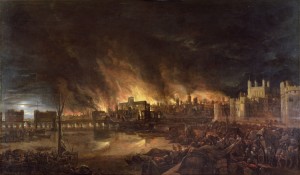350 Years Ago: Great Fire of London
September 2, 2016
Today, September 2, is the 350th anniversary of the start of the Great Fire of London, a disaster that burned much of England’s capital city in 1666. The fire burned for four full days, torching some 436 acres (176 hectares) of the City of London, including 13,200 houses and 89 churches—among them St. Paul’s Cathedral (which was later rebuilt). The fire was a catastrophe at the time, leaving 80 percent of the city’s population homeless. But the fire also rid the city of many overcrowded wooden buildings that had been a breeding-ground for disease (see Great Plague). New buildings of brick and stone replaced London’s wooden houses and set the framework for the modern capital we know today.
From August 30 through September 4, 2016, a variety of events are marking the anniversary of London’s Great Fire, including exhibitions of scorched artifacts and commemorative sculptures and artworks, walking tours and storytelling, outdoor concerts and an opera, and even a bake-off at the site of the bakery where the fire started 350 years ago.

This painting depicts the Great Fire of London, which destroyed much of the city in September 1666. The fire began near London Bridge, at left. The Tower of London, at right, survived the fire. The original St. Paul’s Cathedral, center, engulfed in flames, did not. Credit: The Great Fire of London in 1666, oil on panel, Dutch School (17th century); Museum of London (Bridgeman Images)
Early on Sunday morning, Sept. 2, 1666, a fire began near the oven of the king’s baker, Thomas Farriner, who lived on Pudding Lane near London Bridge. Farriner escaped his house with his family (without the maid, who died), but the fire soon spread and engulfed nearby houses. London houses in the 1600′s were built mainly of wood and they crowded so tightly over the narrow streets that the upper stories almost touched. At that time too, every home had open fires and candles, and it was not unusual for a fire to consume groups of streets, or even entire districts. Farriner’s fire—or rather the Great Fire—spread rapidly, devouring timber buildings and jumping from street to street, district to district. There was no effective firefighting system at the time, and a strong wind from the east fanned the flames through houses made abnormally dry by a long, hot summer.
Eventually, King Charles II personally supervised demolition operations to make an open strip that the fire could not cross, and, when the wind fell, the danger of the fire spreading farther was over. Writer Samuel Pepys described the Great Fire vividly in his Diary. Pepys, who lived near Farriner’s bakery, hired a boat and watched the conflagration from the River Thames. Official records list the fire’s death toll at only six, but the city’s population at the time was a “best guess,” with many poor people unaccounted for, and only charred remains recognizable as human were counted. A melted piece of pottery found near Farriner’s bakery showed that temperatures there surpassed 2,200 °F (1,250 °C).
Architect Sir Christopher Wren designed the new St. Paul’s Cathedral as well as the Monument to the Great Fire of London near the former site of Farriner’s bakery.


